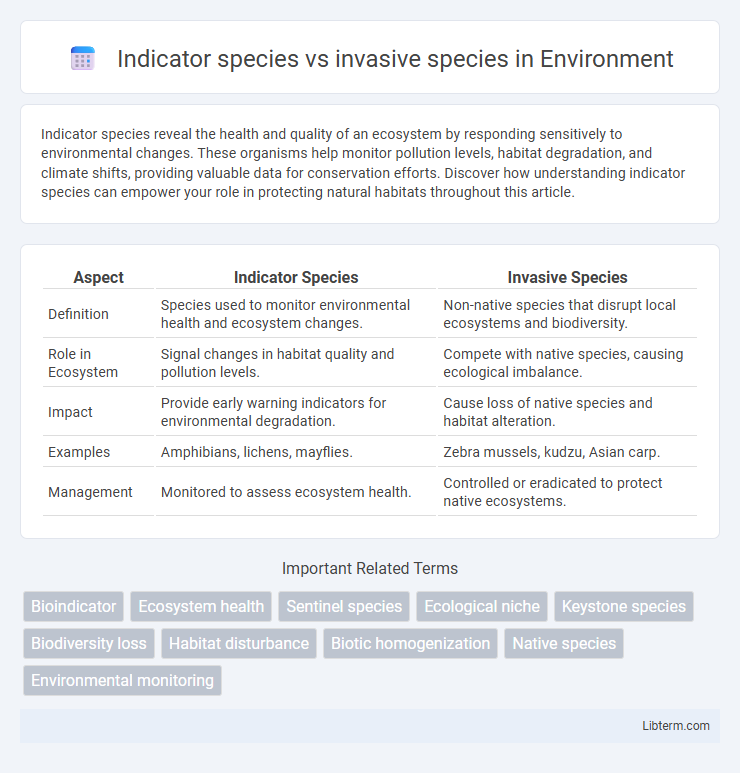Indicator species reveal the health and quality of an ecosystem by responding sensitively to environmental changes. These organisms help monitor pollution levels, habitat degradation, and climate shifts, providing valuable data for conservation efforts. Discover how understanding indicator species can empower your role in protecting natural habitats throughout this article.
Table of Comparison
| Aspect | Indicator Species | Invasive Species |
|---|---|---|
| Definition | Species used to monitor environmental health and ecosystem changes. | Non-native species that disrupt local ecosystems and biodiversity. |
| Role in Ecosystem | Signal changes in habitat quality and pollution levels. | Compete with native species, causing ecological imbalance. |
| Impact | Provide early warning indicators for environmental degradation. | Cause loss of native species and habitat alteration. |
| Examples | Amphibians, lichens, mayflies. | Zebra mussels, kudzu, Asian carp. |
| Management | Monitored to assess ecosystem health. | Controlled or eradicated to protect native ecosystems. |
Understanding Indicator Species: Definition and Importance
Indicator species serve as vital biological monitors that reveal the health of an ecosystem through their presence, absence, or population trends. These species provide early warning signs of environmental changes, pollution levels, or habitat degradation, enabling timely conservation actions. Understanding the role of indicator species enhances ecosystem management by highlighting critical shifts in biodiversity and ecological conditions.
What Are Invasive Species? Key Characteristics
Invasive species are non-native organisms introduced to new environments, where they thrive and cause harm to native ecosystems, economies, or human health. Key characteristics include rapid reproduction, high dispersal ability, strong adaptability to diverse habitats, and lack of natural predators, enabling them to outcompete native species. These traits lead to biodiversity loss, alteration of habitat structure, and disruption of ecological processes.
Ecological Roles: Indicator vs Invasive Species
Indicator species provide critical data on ecosystem health by reflecting environmental changes and pollution levels, enabling early detection of habitat degradation. Invasive species disrupt native biodiversity by outcompeting indigenous organisms for resources, altering food webs, and causing ecological imbalance. Understanding these contrasting ecological roles aids in conservation efforts and informs environmental management strategies to maintain ecosystem stability.
Habitat Preferences and Distribution Patterns
Indicator species exhibit specific habitat preferences closely tied to environmental conditions, serving as reliable markers for ecosystem health and stability. In contrast, invasive species often display broad habitat tolerances and aggressive distribution patterns, enabling rapid colonization across diverse ecosystems and outcompeting native flora and fauna. Understanding these distinct habitat preferences and distribution dynamics aids in biodiversity conservation and invasive species management strategies.
Impact on Biodiversity and Ecosystems
Indicator species provide crucial information about the health and quality of ecosystems, often signaling changes in biodiversity due to environmental stress or pollution. Invasive species disrupt native ecosystems by outcompeting indigenous flora and fauna, leading to reduced biodiversity and altered ecosystem functions. The impact of invasive species tends to be detrimental, causing habitat degradation and loss of ecosystem services, whereas indicator species help monitor and manage ecosystem integrity.
Examples of Indicator Species in Different Environments
Indicator species provide critical information about the health of various ecosystems, such as lichens in air quality assessment, amphibians like frogs in freshwater monitoring, and corals in marine environments. Their presence or absence signals environmental changes, pollution levels, and habitat integrity. These species contrast with invasive species, which disrupt ecosystems rather than reflecting their condition.
Notable Invasive Species and Their Effects
Notable invasive species such as the zebra mussel (Dreissena polymorpha) and emerald ash borer (Agrilus planipennis) drastically alter ecosystems by outcompeting native species and disrupting food webs. The zebra mussel's rapid colonization clogs water intake pipes and depletes plankton, which negatively impacts fish populations and water quality. Emerald ash borer larvae inflict severe damage on ash trees, leading to widespread tree mortality and reduced biodiversity in North American forests.
Detection and Monitoring Methods
Indicator species are monitored using bioassessment techniques such as population surveys, habitat quality assessments, and chemical analysis of environmental samples to detect ecosystem changes. Invasive species detection relies heavily on early warning systems including remote sensing, environmental DNA (eDNA) sampling, and automated traps to monitor spread and density. Both approaches integrate GIS mapping and citizen science data to enhance spatial and temporal resolution in monitoring efforts.
Conservation Strategies: Managing Indicator and Invasive Species
Effective conservation strategies prioritize managing indicator species to assess ecosystem health and guide restoration efforts, while controlling invasive species to prevent biodiversity loss and habitat degradation. Monitoring indicator species populations provides critical data for adaptive management, enabling targeted interventions in vulnerable habitats. Invasive species management often involves habitat restoration, removal programs, and public awareness campaigns to reduce ecological disruption and support native species recovery.
Future Challenges and Research Directions
Future challenges in studying indicator species revolve around accurately predicting ecosystem health amid climate change and habitat fragmentation, necessitating advanced monitoring technologies and data integration methods. Invasive species research increasingly focuses on understanding their genetic adaptability and interactions with native communities to develop more effective management strategies. Emerging directions include leveraging remote sensing, environmental DNA (eDNA), and machine learning to enhance detection, control, and ecological impact assessment of both indicator and invasive species.
Indicator species Infographic

 libterm.com
libterm.com